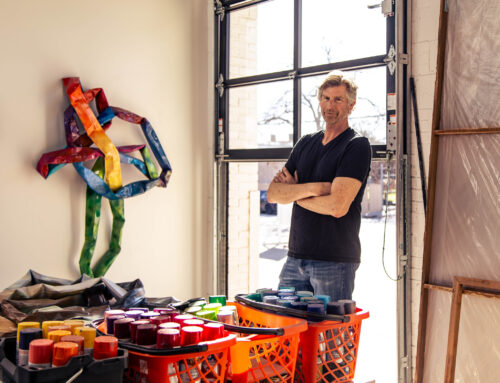Quilts have played a prominent role in Marian Ann Montgomery’s life.
The first stitch began with her great-grandmother, who was a talented quilter.
“My mother, later in life, woke me up one morning and said, ‘Would you like to see your great grandmother’s quilt?’ And she showed it to me by throwing it on the bed,” Montgomery recalls.
But she never met that great grandmother who helped pass the time with a needle and thread, and she’s not a prolific quilter herself.
No, quilts have woven the fabric of Montgomery’s professional life. She is, among other things, a quilt historian. She’s also an independent museum consultant who is getting ready to see years of hard work pay off.
This month, the largest exhibition ever dedicated to quilting, called Quilt Mania, is opening in 11 museums and venues around the Metroplex. Montgomery, who lives in Preston Hollow with husband Barry and dog Benjamin, is acting as the project’s coordinating curator.
“There will be 150 quilts in this exhibition, and no one place in town could hold all of this,” she says.
The Quilt Mania idea started small in 2000 after she’d finished a gig as founding curator and director of exhibitions of the Women’s Museum. Bonny Speed, then director of the Trammell and Margaret Crow Collection of Asian Art, came to her with an idea to do an exhibit of Japanese quilts.
“Quilting originated in Asia. Marco Polo brought it back from Asia to Europe,” Montgomery says.
From that conversation, a round-table started. And before they knew it, places such as the African American Museum, Old City Park, The Science Place, Thanksgiving Square, The McKinney Avenue Contemporary (MAC), the Irving Arts Center and others had come on board.
In addition to the dozens of quilts, some of the venues, such as the MAC and The Science Place, will have exhibits that feature quilt-like artwork and the advancing technology of the craft.
So what does it say about quilting that its appeal and scope can cover such a mix of venues?
“That it’s universal, and that we all sleep under something,” Montgomery jokes, adding: “And that it’s an art form that can be easily understood by people who may never have been to a museum. And I think women – and men too, really – find pleasure in working with fabric and touching it. It’s that whole tactile thing.”
Montgomery’s expertise and fascination with quilting evolved throughout her life. She was born in Pennsylvania, which, along with New York, Texas and Tennessee, “tend to be hotbeds of quilting,” she says.
She received her bachelor’s in home economics education from Central College in Iowa, her master’s in museum studies and American decorative arts from Cornell, and her doctorate in museum administration, with a concentration in fashion and textile history, at NYU.
But it wasn’t until a stint in Nashville that she really started to focus on quilting.
“When you end up as the curator of fashion and textiles at the State Museum in Tennessee, your chances of finding interesting quilts are a whole lot better than finding interesting fashion,” she says.
Upon her return to Texas, she continued with the Dallas Museum of Art’s quilt collection. Wanting to build relationships in the community, she contacted the Quilters Guild of Dallas, one of the largest in the country.
“I really found a home with them,” she says.
Montgomery didn’t start quilting herself until her late 20s, and she makes machine-pieced quilts with “a strong geometric focus.” As to why she enjoys making quilts in addition to studying the craft, she explains it this way: “When I was opening the Women’s Museum, which was a very fast track project. I came home at the end of the day to the quilt I was working on at the time, and it didn’t argue with me, and it never told me it was going to be late on a deadline.”
And she has a great amount of admiration for the dedication that 19th century women settlers showed to quilting.
“American women on the frontier really took it to an art form. It was their only gallery,” she says. “These women couldn’t go to art school, they couldn’t study with the Impressionists in Paris. So the bedroom became their gallery.”
And now, with the help of those like Montgomery, their work endures with Quilt Mania.






